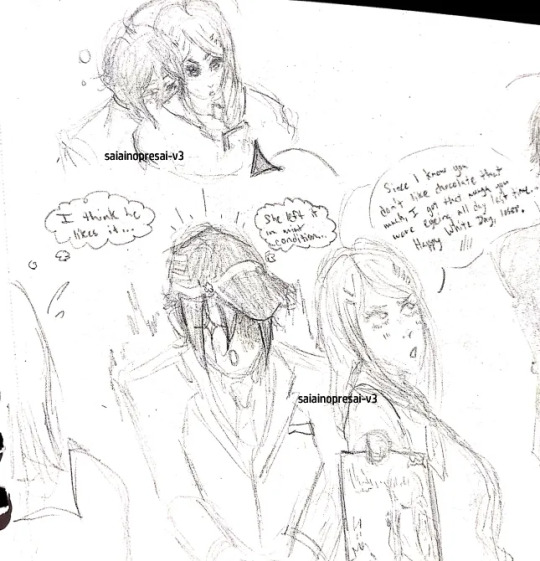#but also hopefully should allow for more readability on the last bubble...? or maybe its the reverse. dunno. let me know lol
Explore tagged Tumblr posts
Text




some (very late) white day themed [pregame] saimatsu!
i meant to upload these sooner but i was figuring out scanning and. i think its. pretty obvious im still figuring it out. but! they're not too bad i think. ill figure it out as i go LMFAO
#sorry about the noise </3 as i said theyre scanned so any rough pencil just got. picked up as dotted noise?? LMFAO#the quality of the 3rd one tho. yeesh#the last one isnt as edited-- bc the noise was like. esp bad </3#but also hopefully should allow for more readability on the last bubble...? or maybe its the reverse. dunno. let me know lol#shuichi saihara#saihara shuichi#saihara shuuichi#pregame shuichi#pregame saihara#pregame shuichi saihara#kaede akamatsu#akamatsu kaede#pregame kaede#pregame kaede akamatsu#pregame saimatsu#saimatsu#pregame#ndrv3#drv3#ndrv3 spoilers#drv3 spoilers#danganronpa spoilers#my art#white day
59 notes
·
View notes
Text
Six years after the release of Marvel vs Capcom 3, which recently was ported to this generation of consoles, it is finally time for Capcom to reveal its new opus of this cross-franchise fighting game, with the rather very different Marvel vs Capcom Infinite. With the aim of appealing to a bigger audience, did Capcom manage to do so without pushing away fans of the series?
Who ever had the idea to unite the Marvel universe with the world of Capcom could give birth to such an unexpected and successful crossover? A series that kicked off back in 1996 with over 4 different editions over the years, this new opus is banking heavily on making some sort of sense of how these two universe collides. Marvel vs Capcom Infinite tells the story of an interplanetary chaos set by Ultron Sigma, born from a cross between Ultron (Marvel’s iconic robot evil) and Sigma (the main antagonist of Mega Man X). Thanks to the two Infinity Stones which he has in his possession (another key Marvel reference), which are linked to Space and Reality, he managed to merge these two worlds together. Like any big villain wishing to control the galaxy (and all dimensions), Ultron Sigma wants to shape it to its effigy, seeing himself and peers as a supreme god of living beings. In any case, a bunch of heroes from both Marvel and Capcom will have to put their egos aside, in order to recover the six Infinity Stones, to accomplish their mission and defeat this ultimate evil.
This previous paragraph is basically the story of the “Story Mode” found in the game, something Capcom omitted in the previously launched Street Fighter V, which should be something amazing if it wasn’t for this script that is all over the place, barely piecing things together, confusing you along the way like some sort of 12 season running soap opera where the mother is now the adopted daughter of the father of the main actor’s wife. I’m not going to bash it much, and I did particularly enjoyed the frantic pace of the story but after actually enjoying the ones in Tekken 7 and Injustice 2 (both reviewed earlied this year), and with the narrative direction of Marvel, this game would’ve been better at telling a tale of mighty heroes saving the world. The relatively dynamic stage set for these character is reinforced by the humor of certain ones like the devilish Dante from Devil May Cry, Frank West from Dead Rising, or everyone’s favorite angry and facetious Rocket Raccoon from Guardians of the Galaxy. We simply regret that not everyone was entitled to the same preferential treatment, and some character are either fillers or just really in bad roles.
I would say the main issue here with maybe not enjoying the story mode other than the script is two simple things: graphical quality and loading time. While the latter doesn’t need much explaining, Marvel vs Capcom Infinite has a really long loading time between the story mode cutscenes and the actual fights, which kills the flow and annoys the impatient players. The second point is the character design of almost the entire roster. I get that blending Marvel and Capcom character styles is a feat of its own considering the different artistic origins of each media house, but there’s not enough compromise on each end, which gives us some very weird versions of our heroes. If Chun-Li got “fixed” successfully after the feedback of the community, Ryu looks rather cubic during the cinematic, and Dante almost looks nothing like the Demon hunter we know. To finish on the graphical part of the game, the game is still a feast for the eyes in battle, with volley of visuals mashing through the screen, especially supers that are so crazy that it could give instant epilepsia attacks.
Before attacking into the heart of the title which is the gameplay, Capcom seemed to have learned the lesson in terms of content at launch. When playing offline, you’ll have no less than six modes ranging from Story, Arcade, Mission (which are sets of challenges to learn each character’s combos), the inevitable Training, and finally Versus with friend or CPU mode. The Collection is added as a bonus, and includes information about each heroes, the music of the game, and cinematics to replay. For those of you brave enough to play online (or those with decent connections), you can then access to Ranked match, Casual Match, and the Beginners League (for those under the level 14), Lobbies to accommodate up to eight players, Rankings to see the world’s leaderboards, and finally a replay feature to rewatch all of your previous matches.
Now that we tackled everything, how’s Marvel vs Capcom Infinite when it comes to gameplay, and has it been really turned into a casual mess to attract newcomers? Thankfully no, and if the game made drastic changes that may be detrimental to the series, the overall package is still decent. First of all is the switch from a 3v3 to a 2v2 combat, something that has only been done in the Tatsunoko vs Capcom series (my personal favorite of these crossover franchises). While this choice has been made to enhance readability so that the action is more clear than it was before, I now understand this with the new generation graphic engine, as a three player mashup would’ve become a gigantic sore for the eyes. This also makes it easier for Capcom to reconquer the pros of the Marvel vs Capcom fight, and hopefully have enough leverage to add the game in its annual Capcom Pro Tour.
This slideshow requires JavaScript.
In addition, the gameplay, specifically the combos, have been made much easier to input. Unlike the technical tenors of the genre (Street Fighter, Guilty Gear, Tekken), big attacks that used to require a severe set of input can be done by pressing for example LT + RT, or a quarter circle followed by the combination of low and high punch. This simplification thus has the consequence of making the whole more accessible to ordinary players, and thus gives this immediate pleasure of play which does not require to get your thumb sores to see these amazing super moves. On the one hand, and although it can be played in the high ranks of the fighting game community, the franchise is not specially known for its technicality. Moreover, the combos, hyper and super automated jumps can be deactivated, relying on you to customize the experience to your liking, so you can do the combos like the good ol’ days.
Marvel vs. Capcom Infinite shares another common trait with Tatsunoko vs. Capcom: the presence of the second character, which can be used if the main one is KOed, and more interesting acts as a helper to establish a chain of combos. Exploited as it should, in other words by having the right timing, the Active Switch can be turned into an ability to break the movements of your enemy, even the most impressive ones. However, you will need to make sure you have two bars of Super in stock, otherwise it will not work. A good other part of this dynamic is that fighters that are “out of the ring” will recover a certain amount of health with time, which can call for some fun last minute switch of tactics.
You’d think that it’s enough to change the recipe, but there’s is one parameter that still allows to change things around which are key to the whole direction of the game: the Infinity Stones. Like in the Marvel universe, there are six of them, which you will have to pick one at the beginning of each match, according to your affinities, your pair of characters picked, and obviously your opponent. Whether it is the Stone of Reality, Time, Power, Soul, Mind or Space, these invaluable jewels with “infinite” powers can shape and alter the game. These will obviously activate numerous unique abilities depending on the stone, whether it is an Infinity Surge (LB) or an Infinity Storm (LB+RB). I’m not going to explain the whole are not going to make the inventory at the risk of falling asleep, but it is necessary to give you some examples. Let’s say you decided on picking the “Mind” Stone: the Infinity Surge allows you to lock your opponent in a suspended bubble that stun him for a short moment, provided that you are close to him since. But when you switch to the “Infinity Storm” state (which is activated once you hit 50% of your Infinity bar), your Super gauges fill up at crazy speed, leaving you to freely go mental and abuse Super moves.
Marvel vs Capcom Infinite was reviewed using an Xbox One downloadable code of the game provided by Capcom. The game is also available on PlayStation 4 and PC in online and retail store releases. We don’t discuss review scores with publishers or developers prior to the review being published.
With this new episode, Marvel vs Capcom Infinite retains its core elements while drastically modifying certain gameplay features in order to seduce as many newcomers as possible. Six years after the release of Marvel vs Capcom 3, which recently was ported to this generation of consoles, it is finally time for Capcom to reveal its new opus of this cross-franchise fighting game, with the rather very different Marvel vs Capcom Infinite.
0 notes